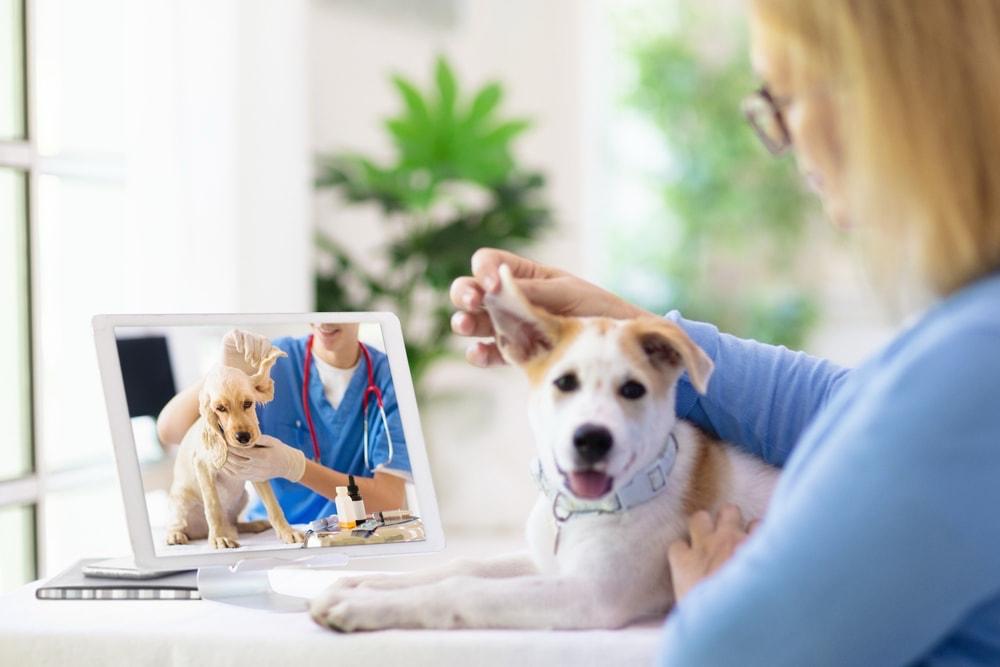
Virtual Vet Visits: Are Online Consultations Reliable?
As pet healthcare embraces digital innovation, virtual vet visits are becoming increasingly popular, allowing owners to consult licensed veterinarians from home via video calls, apps, and smart devices. While convenient and accessible, questions remain about their reliability for accurate diagnosis, chronic care, and emergencies. This article explores the benefits, limitations, technology, and future of online veterinary consultations in 2025.
🐶 Pet Star
54 min read · 22, Oct 2025

Introduction: The Digital Revolution in Pet Healthcare
The year 2025 marks a significant milestone in the evolution of pet care. As telemedicine becomes mainstream for humans, the veterinary world is following closely behind. The rise of virtual vet visits, often conducted via video calls or specialized apps, is transforming how pet owners access medical advice. No longer do pet parents need to bundle their anxious pets into carriers or wait for appointments—help is available at the click of a button.
However, with this convenience comes skepticism. Can a veterinarian truly diagnose an illness without physically examining an animal? Can subtle symptoms—like a change in heartbeat, temperature, or hidden injuries—be properly identified online? And most importantly, are virtual vet consultations reliable enough to safeguard the health of our furry companions?
To answer these questions, we must look deeper into how tele-veterinary services function, their benefits, their limitations, and what the future holds for this digital form of pet care.
The Rise of Tele-Veterinary Medicine
Virtual veterinary care is part of a larger global movement toward digital healthcare. The COVID-19 pandemic acted as a catalyst, pushing veterinary clinics to adopt remote consultation technologies when in-person visits were restricted. By 2023, many veterinary hospitals had already integrated telemedicine platforms into their daily operations.
In 2025, tele-vet apps such as PawCare, Vetster, TeleVet, and FirstVet are becoming household names. These platforms connect pet owners with licensed veterinarians through real-time video, audio, or text consultations. The process is simple: you upload your pet’s symptoms, photos, or videos, and within minutes, a qualified vet provides advice, prescriptions, or referrals.
What started as a necessity has now evolved into a preferred method of care for many. Surveys suggest that over 60% of millennial pet owners have used or plan to use virtual vet services. But popularity doesn’t always equate to reliability, and this is where the debate intensifies.
How Virtual Vet Visits Work
A virtual vet consultation typically follows a structured process:
- Initial Contact:
- The pet owner selects a consultation type—urgent care, follow-up, behavior consultation, or nutrition advice—through a digital platform or app.
- Data Submission:
- The owner provides the pet’s details (age, breed, weight, medical history) and uploads photos or short videos showcasing symptoms such as rashes, limping, or unusual behavior.
- Live Consultation:
- Through a secure video call, the veterinarian evaluates the pet, asks targeted questions, and visually examines the animal’s condition.
- Diagnosis or Guidance:
- Based on the assessment, the vet may recommend at-home treatments, prescribe medication (if local laws permit), or suggest an in-person visit for further tests or emergency care.
- Follow-up:
- Many platforms offer follow-up messaging for additional questions or to review recovery progress.
While it’s clear that tele-vet consultations can streamline routine and non-emergency care, they are not designed to replace hands-on examinations in critical situations.
Benefits of Virtual Vet Consultations
1. Convenience and Accessibility
Pet owners in rural or remote areas often struggle to find immediate veterinary care. Virtual consultations bridge this gap, allowing them to connect with specialists hundreds of miles away. Even in urban areas, avoiding long waits and travel stress is a major advantage.
2. Reduced Stress for Pets
For many animals, vet visits can be traumatic. The noise, unfamiliar environment, and other animals can cause anxiety. Virtual visits let pets stay in their comfort zone, making diagnosis of behavioral or mild health issues easier.
3. Cost-Effective Care
Online consultations are typically cheaper than in-clinic visits. Without the overhead costs of physical facilities, tele-vet services can offer affordable access to professional advice, especially for routine concerns.
4. Quick Access to Expert Opinions
Through online platforms, pet owners can connect with specialists—dermatologists, nutritionists, behaviorists—who might not be available locally. This enables better management of chronic conditions.
5. Great for Follow-Ups and Minor Issues
Virtual visits are excellent for post-surgery checkups, dietary adjustments, or mild skin irritations. These situations rarely need physical examination and can be effectively handled via video calls.
Limitations and Risks of Online Vet Visits
Despite the growing appeal, virtual veterinary care has clear boundaries. Understanding these limitations is crucial for responsible pet ownership.
1. Lack of Physical Examination
A vet’s hands are essential diagnostic tools. Palpating an abdomen, checking a heartbeat, or examining an ear canal can’t be done virtually. This limits the accuracy of diagnoses in many cases.
2. Regulatory Restrictions
Veterinary telemedicine laws vary by region. In many places, veterinarians must establish a Veterinarian-Client-Patient Relationship (VCPR) through an in-person exam before offering virtual consultations or prescriptions. This regulation ensures patient safety but limits the scope of virtual care.
3. Potential for Misdiagnosis
Without tactile examination or lab tests, online vets must rely heavily on visual cues and owner descriptions—which may be incomplete or inaccurate. A blurry video or poor lighting can lead to mistaken assumptions.
4. Not Suitable for Emergencies
In critical conditions such as choking, severe bleeding, fractures, or poisoning, virtual care can waste precious time. Most tele-vet platforms clearly state that they are not emergency services.
5. Technological Barriers
Internet connectivity issues, camera quality, or lack of familiarity with technology can reduce the effectiveness of the consultation—especially for older pet owners.
When Virtual Vet Visits Work Best
Virtual vet visits are most reliable when used for:
- Routine follow-ups after surgery or treatment
- Skin conditions, rashes, or allergies
- Digestive issues like mild vomiting or diarrhea
- Behavioral consultations (anxiety, aggression, training)
- Nutrition and diet planning
- Preventive care and parasite management
For anything involving trauma, breathing difficulties, eye injuries, or unresponsiveness, physical veterinary intervention is mandatory.
Technological Innovations Making Virtual Vet Visits More Reliable
By 2025, emerging technologies are enhancing the accuracy of online consultations:
1. Smart Collars and Wearables
Devices like FitBark, Whistle, and PetPace now monitor heart rate, temperature, respiration, and activity levels in real-time. Data from these devices can be shared with online vets for more accurate assessments.
2. AI Symptom Checkers
Advanced AI-driven tools can analyze pet symptoms and provide preliminary evaluations before the vet call begins. These AI assistants are improving triage accuracy and consultation efficiency.
3. Remote Diagnostic Kits
Some companies provide at-home testing kits for urine, fecal, or saliva samples. Owners can collect samples and send them to labs while consulting with vets online—bridging the gap between telemedicine and traditional diagnosis.
4. Integration with Electronic Health Records (EHR)
Veterinary telemedicine platforms are integrating with digital health records, ensuring continuity of care. This allows in-clinic vets to review past online consultations for better treatment planning.
The Human Factor: Trust and Communication
One of the biggest determinants of a successful virtual vet visit is effective communication. Since pets can’t speak for themselves, owners must accurately describe behaviors, symptoms, and changes. Similarly, veterinarians must be skilled at reading subtle nonverbal cues and asking precise questions.
Building trust through digital screens is challenging. Many pet owners prefer in-person interactions for emotional reassurance. Yet, with time, transparency, and consistent follow-up, virtual vets are successfully earning the confidence of clients worldwide.
The Future of Virtual Veterinary Care
Looking ahead, virtual vet care is poised for even greater integration into mainstream pet healthcare. Artificial Intelligence, machine learning, and IoT (Internet of Things) devices will make telemedicine smarter, more data-driven, and more reliable.
Hybrid models are expected to dominate—combining in-person exams for initial diagnosis with virtual follow-ups for ongoing monitoring. Veterinary schools are also incorporating telemedicine training, ensuring future vets are digitally fluent.
Regulatory frameworks will likely evolve too, creating global standards for online consultations, prescriptions, and data privacy. As technology matures, what once seemed “unreliable” may soon become the norm in pet healthcare.
In the rapidly evolving landscape of pet healthcare in 2025, virtual veterinary consultations have emerged as both a revolutionary convenience and a subject of debate regarding their reliability, as advancements in technology, digital communication, and telemedicine platforms have allowed pet owners to access professional veterinary advice without leaving the comfort of their homes, thereby eliminating the stress and logistical challenges associated with transporting anxious or elderly animals to clinics, particularly in rural or underserved areas where veterinary services may be sparse or located far from population centers; these consultations typically involve pet owners submitting detailed information about their pets, including age, breed, medical history, and current symptoms, often accompanied by high-resolution photos or videos that showcase behavioral changes, visible injuries, skin irritations, or other physical anomalies, which veterinarians then analyze during live video or audio sessions to provide guidance on care, treatment options, or necessary follow-up visits, while some platforms also integrate AI-driven symptom checkers that assist both pet owners and veterinarians by offering preliminary assessments based on data input, thereby streamlining the consultation process and helping prioritize urgency; further enhancing the reliability of such services are wearable devices and smart collars, which continuously monitor pets’ vital signs, activity levels, heart rate, temperature fluctuations, and sleep patterns, transmitting this data in real time to the veterinarian so that any subtle changes in health or behavior can be detected promptly, which is particularly valuable for managing chronic conditions such as diabetes, arthritis, or heart disease, as well as monitoring recovery post-surgery or post-treatment; however, despite these technological advancements, the inherent limitations of virtual vet visits must be acknowledged, as the absence of tactile examinations, palpation, auscultation, and in-depth diagnostic procedures can make accurate assessment of complex or internal conditions challenging, which is why emergencies such as poisoning, fractures, respiratory distress, or acute trauma always necessitate in-person intervention, since delayed treatment in such scenarios could jeopardize the animal’s health or even become life-threatening; moreover, regional regulatory frameworks often mandate that a veterinarian establish a formal veterinarian-client-patient relationship (VCPR) through an initial physical examination before prescribing medications or issuing treatment plans, which means that virtual consultations are best suited for follow-ups, preventive care, minor illnesses, behavioral consultations, and nutritional guidance, while simultaneously serving as an important tool for triage and decision-making that helps pet owners understand whether an in-person visit is truly required; the effectiveness of online veterinary care also depends heavily on communication skills, as veterinarians must interpret nuanced behaviors and visual cues via video, while pet owners are responsible for accurately describing symptoms, routines, and environmental factors, all of which directly influence diagnostic accuracy; additionally, tele-veterinary platforms are increasingly integrating electronic health records (EHR), enabling seamless continuity of care where online consultation histories, prescriptions, lab results, and treatment plans are accessible to both remote and in-clinic veterinarians, thereby reducing redundancy, improving efficiency, and fostering a more comprehensive understanding of the pet’s medical background; the financial and logistical advantages of virtual vet visits are significant, as these consultations often cost less than traditional appointments due to the absence of overhead costs associated with physical clinics, while also saving time, transportation expenses, and minimizing stress for both pet and owner, which encourages routine health monitoring, early detection of minor issues before they escalate, and adherence to preventive care schedules such as vaccinations, flea and tick treatments, and dietary adjustments; further, the integration of AI tools, machine learning algorithms, and telemonitoring devices is gradually improving diagnostic precision by providing vets with data-driven insights that complement observational assessment, enabling more accurate recommendations even in the absence of a hands-on examination, while hybrid models that combine in-clinic visits with subsequent virtual follow-ups are emerging as the most reliable and efficient approach, as they allow for thorough initial assessments followed by convenient remote monitoring; as technology continues to advance, including innovations in at-home diagnostic kits, remote imaging devices, and AI-powered predictive tools, the scope and reliability of virtual veterinary medicine are expected to expand significantly, making it an indispensable component of modern pet healthcare while maintaining a balance with traditional, hands-on veterinary care to ensure that pets receive comprehensive, safe, and timely medical attention; ultimately, the reliability of virtual vet visits hinges on a combination of appropriate use cases, technological support, skilled veterinary communication, and owner engagement, and when applied correctly, these consultations can significantly enhance the overall standard of pet care, improve accessibility for underserved populations, reduce stress and cost, and provide a scalable solution for managing the growing global pet population, thereby illustrating that while online consultations may never fully replace physical examinations, they represent a critical evolution in veterinary medicine, offering an effective, complementary pathway for routine care, early detection of health issues, chronic condition management, and ongoing veterinary guidance that empowers pet owners and enhances the quality of life for animals across the world.
In recent years, the concept of virtual veterinary consultations has evolved from a niche service to a mainstream component of pet healthcare, as advances in technology, high-speed internet, and telemedicine platforms have enabled pet owners to seek professional advice without leaving their homes, thereby reducing the stress associated with transporting animals—particularly those that are elderly, anxious, or have mobility issues—and increasing access to veterinary care for families living in remote or underserved regions where clinics may be few and far between, while these online consultations typically involve a detailed submission of a pet’s history, age, breed, and current symptoms, often accompanied by high-resolution images or video recordings of behaviors, visible injuries, skin conditions, or other noticeable signs, which veterinarians then analyze during real-time video calls, asking targeted questions to clarify observations and, in many cases, leveraging AI-powered symptom checkers integrated into platforms to provide preliminary assessments and streamline the consultation, and this combination of human expertise and technological assistance has made virtual vet visits highly effective for a range of scenarios, including minor illnesses, skin irritations, digestive issues, post-surgery follow-ups, behavioral consultations, nutritional guidance, and preventive care, particularly as many platforms now allow seamless integration with wearable devices or smart collars that monitor a pet’s activity, heart rate, temperature, sleep patterns, and other vital signs, transmitting real-time data to the veterinarian so subtle health changes can be detected quickly, which is particularly valuable for managing chronic conditions such as arthritis, diabetes, heart disease, or obesity, yet despite these advantages, there are inherent limitations that make online consultations less reliable for complex or emergency cases, as the absence of tactile examinations, auscultation, palpation, and advanced diagnostics can prevent a veterinarian from fully assessing internal or subtle issues that may be critical to a pet’s well-being, and as a result, most tele-vet platforms caution against using virtual visits for life-threatening emergencies such as poisoning, fractures, severe bleeding, respiratory distress, or sudden collapse, as immediate in-person attention is required to prevent complications or fatalities, furthermore, regulatory frameworks in various regions mandate that veterinarians establish a formal veterinarian-client-patient relationship through an initial in-clinic evaluation before providing prescriptions or treatment plans online, which ensures safety but also restricts the scope of virtual consultations, making them more suitable for follow-ups, preventive care, behavioral advice, minor ailments, and triage, while simultaneously serving as an effective tool for determining whether an in-person visit is necessary, and the accuracy of virtual consultations depends heavily on effective communication, with veterinarians needing to interpret visual cues, subtle behaviors, and owner-reported symptoms, and pet owners required to provide precise, detailed descriptions of their pet’s routine, environment, and any changes in behavior, feeding, or mobility, as miscommunication or incomplete information can increase the risk of misdiagnosis, yet the introduction of technology such as AI-based symptom analysis, machine learning algorithms, and cloud-based electronic health records has enhanced the reliability of remote consultations by providing vets with data-driven insights, enabling more informed decision-making even in the absence of a physical exam, and some platforms also support remote diagnostic kits, allowing owners to collect samples for laboratory testing at home, which are then analyzed by professionals in conjunction with the online consultation to further improve accuracy, and when combined with wearable technology and continuous monitoring, these developments provide a comprehensive approach to pet care that extends beyond the limitations of traditional telemedicine, while also reducing cost, travel time, and stress for both pets and owners, making routine monitoring and preventive interventions more feasible, particularly for busy or mobility-limited households, and this convenience has contributed to a significant increase in the adoption of virtual vet services, as owners appreciate the accessibility, speed, and affordability, as well as the opportunity to consult with specialists who may not be locally available, such as dermatologists, behaviorists, or nutrition experts, however, it is crucial to recognize that virtual vet visits are complementary rather than a replacement for traditional veterinary care, as physical examinations remain indispensable for accurate diagnosis and treatment of severe or complex medical conditions, and hybrid care models are increasingly emerging, combining initial in-person evaluations with subsequent virtual follow-ups to provide continuity of care, optimize convenience, and maximize efficiency, while technological innovations continue to expand the potential of online consultations, including the development of remote imaging devices, advanced AI diagnostics, predictive analytics, and smart-home monitoring systems for pets, all of which are likely to further improve reliability and enable veterinarians to make more precise recommendations, and as tele-veterinary medicine becomes more integrated into mainstream pet healthcare, it is anticipated that regulatory frameworks will evolve, potentially standardizing practices, ensuring data privacy, and expanding the scope of online care, thereby providing greater confidence to pet owners about the reliability of virtual consultations, and ultimately, when used appropriately for non-emergency, routine, preventive, or chronic care management, virtual vet visits represent a transformative advancement in pet healthcare, offering unparalleled accessibility, convenience, and data-driven insights, while still emphasizing the necessity of traditional, hands-on veterinary expertise in critical situations, making tele-veterinary care a powerful, complementary tool that enhances the overall quality of life for pets and supports owners in making informed, timely decisions for the health and well-being of their animals, illustrating that the future of veterinary medicine is increasingly hybrid, technologically enabled, and focused on combining the best of both virtual and in-person care to ensure that pets receive comprehensive, safe, and effective healthcare tailored to their unique needs.
Conclusion
Virtual vet visits are no longer an experimental trend—they’re a practical, accessible, and affordable reality for millions of pet owners. While they can’t replace hands-on veterinary care entirely, they offer valuable support for non-emergency situations, preventive health, and follow-up consultations.
Their reliability depends on context—for minor issues, behavioral advice, or nutritional guidance, virtual consultations are highly effective. For emergencies or cases requiring physical examination, traditional in-person visits remain irreplaceable.
As technology continues to evolve—with smart collars, AI tools, and improved diagnostics—virtual veterinary care will only become more precise and trustworthy. The key lies in balance: using telemedicine wisely while respecting its limitations.
In essence, virtual vet visits represent not the replacement of traditional veterinary care but its digital extension—a bridge that connects expertise with accessibility in the modern pet-loving world.
Q&A Section
Q1 :- Are virtual vet visits as reliable as in-person consultations?
Ans:- Virtual vet visits are reliable for routine, non-emergency cases such as skin conditions, dietary consultations, and behavioral issues. However, they cannot replace physical examinations or diagnostics required for serious conditions.
Q2 :- Can veterinarians prescribe medication through virtual consultations?
Ans:- In some regions, vets can prescribe medication online only if they have an existing Veterinarian-Client-Patient Relationship (VCPR) established through an in-person visit. Laws vary by country and state.
Q3 :- When should I avoid using virtual vet services?
Ans:- Avoid virtual consultations during emergencies like breathing difficulties, poisoning, fractures, or heavy bleeding. These require immediate physical veterinary attention.
Q4 :- What tools improve the accuracy of online vet consultations?
Ans:- Smart collars, AI symptom analyzers, wearable health trackers, and at-home diagnostic kits provide real-time data that enhances the reliability of virtual diagnoses.
Q5 :- Will tele-veterinary medicine replace traditional vet clinics?
Ans:- No. Tele-veterinary care complements traditional vet services by providing accessibility and convenience. The future lies in hybrid models combining online and offline care for the best outcomes.
Similar Articles
Find more relatable content in similar Articles

Composting Pet Waste: A Greener Way to Clean Up...
As pet ownership continues to .. Read More

Virtual Vet Visits: Are Online Consultations Reliable?..
As pet healthcare embraces dig.. Read More

Social Media for Pets: Turning Your Pet into a Digital..
From playful puppies to charis.. Read More

Pets and Mental Health: The Science Behind Emotional H..
Discover the profound impact o.. Read More
Explore Other Categories
© 2024 Copyrights by rPets. All Rights Reserved.